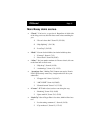
SV Sound
Page 11
Parametric Equalizer (select PB12-Plus subs only). Important enough and
challenging enough, this feature gets its own section! “PEQ” allows you to tame a “peak”
in your room’s natural frequency response. Peaks are quite common, especially in large
rooms or ones where your sub is far from your listening position. NOTE: A Sound Pres-
sure Level meter is a must for proper use of the PEQ, so get one before you tackle this
control. TO DISABLE THIS CONTROL: Set the “LEVEL” control in the Parametric
EQ feature until it stops on “MIN” — thus ensuring you do not inadvertently cause poor
frequency response until such time as you properly configure the PEQ.
First you might ask yourself, “why use a PEQ?” The reason is quite simple. Your room.
Most times even a superlative subwoofer which measures very evenly (we say “flat”) in
an open domain (no reflective boundaries) will not measure the same in your home theater
or music room. Instead, colliding bass waves can build up and cause a “peak”. This is
where a parametric equalizer helps out. A PEQ is an electronic circuit which allows the
user to manipulate the input signal so the acoustical output is more desirable for their envi-
ronment, in many cases allowing the worst peak to be “flattened”. By manipulating the
input signal with your PEQ you can cut a wide or narrow peak in response located some-
where in the frequency range of the equalizer. Importantly, the equalizer found your sub
only allows reduction of peaks, and is “cut only”, not a boost device.
Measure the room’s response. As indicated above, you must have a firm understand-
ing of your room’s acoustical properties before you use a PEQ. To determine your room’s
natural response properties (and your subwoofer, in that room) you will need an SPL meter
shown on Page 6, and at least a pad of graph paper and a pencil for charting as below. If
you have graphing program similar to Microsoft Excel ® this will save some time chart-
ing the response curves. Contact SVS for tips on accessing advanced audio tools you can
use for room analysis. NOTE: Use extreme caution with sine-waves and only run very
low SPLs in the 75dB-85dB region. Sine waves at high SPL’s can damage your SVS!
Room A Response
81
84
87
90
93
96
20 40 60 80 100
Frequency
Freq 20 25 30 35 40 45 50 55 60 65 70 75 80 85 90 95 100
SPL 85 84 86 91.5 95 90 84 84 86 86 85 83.5 83 83.5 84.5 85 86
Figure 3


















